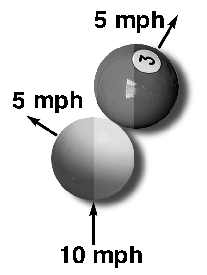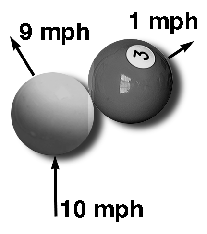You Can Learn to Control Your Speed
| by Jim Meador
Let's say you have become a pretty good shot maker. You can sink an object ball from just about any position on the table&endash; within reason. What's next?
Most players would say "learning position" is the next step, but
that answer is too all encompassing to be very helpful. Playing
position, in the broad sense, involves a large number of cue ball
dynamics beyond just speed. Trying to learn them all simultaneously
can be daunting. So, in order to learn to play position by the
numbers, let's start with the most important factor, which is speed.
If you can surgically control the cue ball's speed with each shot,
it may never be necessary for you to know much more. Master the cue
ball's speed, and you are a master of the game.
If the cue ball never has to contact a rail in order to get position
for each successive shot, your chances of running out are greatly
improved. Now, repeat that last sentence three times. Never forget
it, because ideally, the most desired placement for the next
position shot is one that will not require contact with the rail for
the next shot in the sequence. Although many advanced players prefer
going to a rail for position, in theory anytime the cue ball must
hit a rail for position, the odds of achieving it are reduced. Why?
The fewer concerns we have to deal with on a shot, the more focus
and attention we can give the remaining considerations. For example,
if speed is the only thing we have to worry about to get position,
the goal will be more easily achieved than if we have to calculate
both speed and rebound dynamics off a rail. With good speed control,
it will be easier to get a leave for the second ball, that in turn
will make it possible to get shape for the third, without going to a
rail. This also relates to the reasoning behind planning no more
than three balls ahead. But, even if you must use the rails ( and we
all do) speed is still the critical factor.
The lag is often used to determine who has the break before a game.
Both competitors place their cue balls behind the head string and
simultaneously drive them to the foot rail so that they rebound back
exactly one table length to the head rail. The shooter ending up
nearest the head rail breaks. The lag is the most obvious test of
your speed control. How often do you end up against the head rail
after the lag? How often do you practice the lag? It should be part
of every practice session, because "lag speed" also happens to be an
important and routine stroke for many other shots. Consider lag
speed as a constant around which you build your speed control.
Obviously there is a big difference between controlling speed to the
object ball, and knowing what the speed will be after contact.
Whenever the cue ball hits another ball or the rail, the speed is
reduced by a predictable amount (running english not considered
here). I use a simple formula to help determine how fast the cue
ball will leave the object ball after contact. I have never seen it
used or referred to anywhere else, but it is a system I use to help
others understand the physics involved.
Calculating Cue Ball Deflection Speed
If the cue ball hits the object ball full in the face with no top or bottom english, it will stop dead in its tracks as the object ball takes off at the same speed the cue ball was traveling when it made contact (a small fraction of the energy is lost in the exchange, but not enough to matter.) 100% of the cue ball's energy (or momentum) is surrendered to the object ball.
If the cue ball makes a 3/4 hit on the object ball, it will
surrender 75% (3/4) of its energy to the object ball, and retain
only 25% of its contact speed. The object ball's deflection speed
will be 75% of the cue ball's contact speed. (A 3/4 ball hit is when
the inside edge of the cue ball intersects with a line drawn "3/4"
of the distance from the outside edge of the object ball. The balls
below are shaded to represent these intersecting points.)
3/4 Ball Hit
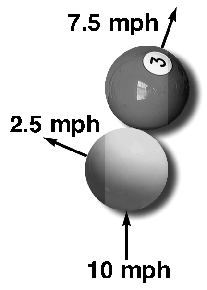
If the cue ball makes a half-ball hit on the object ball it will
surrender half of its energy to the object ball, retain half of its
energy, and both balls will travel at half the speed the cue ball
was traveling before contact. Now the point should be getting
obvious. (Note that both balls below are shaded "1/2" distance in
from their edges.
1/2 Ball Hit
A common mistake in speed control relates to this formula. Too often
the shooter will attempt a very thin hit&endash; let's say a 1/10
ball hit&endash; and fail to realize that the cue ball will retain
90% of its speed after contact, and they over-shoot their position
dramatically.
1/10 Ball Hit
It might be obvious now that whenever the cue ball and object ball
make contact, the deflection speeds of both must add up to 100%,
each with a share of the speed (or energy) determined by the
fullness of the hit. Remember: In order for the total combined
deflection speeds (cue and object ball) to exceed the cue balls
speed at contact, another factor must influence the hit. And it
does. Spin (side, top and bottom) is another form of energy, and
does enter the picture. But that will be discussed at the end of the
session.
Speed Test
Speed relates to distance. With a 3/4 hit, not only will the cue ball deflect at 25%, and the object ball at 75% of the contact speed, the object ball will travel 3 feet for every 1 foot traveled by the cue ball.
In the diagram below the cue ball was stroked with a speed that
would send it 4 feet. When it hits the object ball (a 3/4 hit) the
object ball is sent 3 feet, and the cue ball 1 foot. The distance is
equal to the percentage ratio (3 /1 ft. = 75/25%.)
You can test this for yourself. Put an object ball on the head spot.
Place the cue ball between the object ball and the head rail so that
the inside edge of the cue ball is lined up as shown below. The
inside edge of the cue ball is lined up to intersect a point 3/4 the
distance from the outside edge of the object ball (25% from the
inside edge.) If this is confusing, just set up as shown below.
Stroke the cue softly with a center ball hit. Drive the object ball
3 feet, and then measure the distance the cue ball traveled after
the hit. It should be 1 foot.
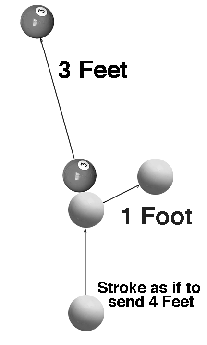
If you drive the object ball 6 feet with this same set-up, the cue
ball should travel 2 feet (6/2=3/1 ratio, or 75/25).
You can test the half-ball (50%) hit the same way. After contact,
both balls should travel at equal speeds and the for same distance.
But what about extremely thin hits? Well, lets try one at lag speed&endash;
the speed that we use to determine who breaks.
Lag Speed Drill
First, practice your lag shot until you can leave the cue ball fairly close to the head rail consistently. This is your drill speed.
Now, set up the table as shown below and pocket the object ball with
a lag speed stroke. If you pocketed the ball with a 1/10 ball hit,
the cue ball will retain 90% of its contact speed and travel about
90% of the distance to the head rail.
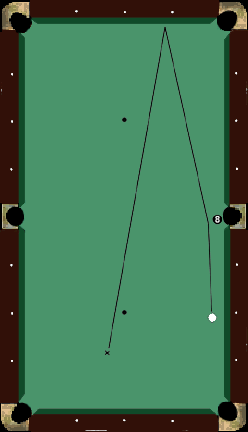
Invent your own speed drills and practice them until your speed
becomes instinctive. If you start thinking about all of the speed
and spin dynamics during a match, you will probably get "brain
clutter" and choke. This is why practice time is so critical.
Remember: "When it's time to perform, the time to practice has
passed."
I stated earlier that other ball dynamics can effect deflection
speed, which in turn effects distance and tangents. Top and
bottom spin are the main considerations. Top spin can dramatically
change the behavior of the cue ball after contact with the object
ball. It will cause the cue ball to travel a greater distance, while
affecting the object ball's speed and distance very little, if any
at all. Bottom spin can slow the cue ball (with cloth friction),
with little or no affect on the object ball's speed.
Side spin can change speed and deflection dynamics to a small
degree. But the value of side spin is only apparent when rail shots
come into play.
Most Popular
Jackass Shooting Pool
Syndrome
Physics of Pool
Bumper Pool
The Masse'
Snooker
Topless Sharking
Selecting a Cue Stick
Long and Straight
Trick Shots
Aiming
Advertisement








